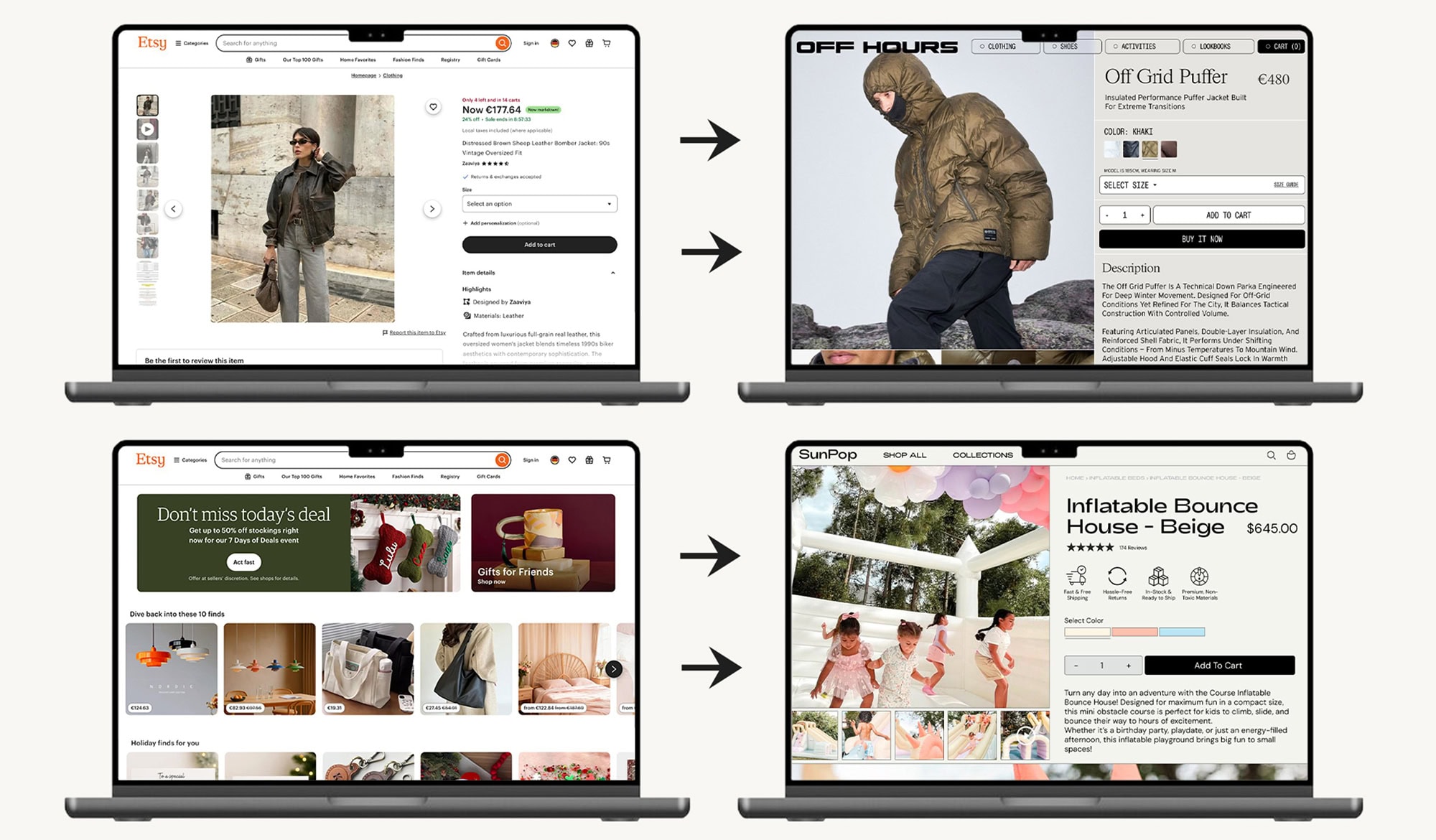The new partnership between Shopify and ChatGPT marks one of the biggest changes in e-commerce history.
OpenAI’s new Instant Checkout feature doesn’t just recommend products — it lets customers complete their purchase directly within the chat. One click, no new tabs, no abandoned carts.
This update brings over one million Shopify merchants into the era of AI-powered shopping. Whether you run a small handmade jewelry store or a global apparel brand, this shift affects you.
How It Works
It’s surprisingly seamless.
A customer types something like “Show me minimalist gold necklaces under $100.”
ChatGPT:
- Finds relevant Shopify products
- Displays them directly in the chat
- Lets the customer confirm and pay instantly
No cart, no checkout page, no distractions — just a direct, frictionless sale.
This means your store can now appear in front of millions of global buyers through AI. But only if your products are optimized to be found and understood.
What This Means for Shopify Merchants
This integration is both an opportunity and a challenge.
ChatGPT becomes a personal shopping assistant that can directly drive traffic and sales to your store. At the same time, competition now centers around which products the AI recommends — and that depends heavily on how well your product data and store are optimized.
How to Prepare Your Shopify Store for the ChatGPT + Shopify Revolution
Step 1: Make Your Product Data AI-Friendly
AI systems like ChatGPT don’t “guess” — they rely entirely on clean, structured data. If your product listings aren’t clear, complete, and consistent, the AI may skip them or fail to recommend them effectively.
Here’s how to optimize your product data for AI discovery:
Title: Include all key details in your product titles, such as brand, product type, material, and use case. For example, instead of just “Men’s Watch,” use “Minimalist Men’s Leather Watch – Stainless Steel, 42mm.” A clear, descriptive title gives AI the context it needs to match your products with the right customer queries.
Description: Write natural, benefit-focused text in complete sentences. Highlight the features, benefits, and unique aspects of your product. Include relevant keywords where appropriate, but avoid keyword stuffing. Well-written descriptions help both AI and traditional search engines understand what you sell.
Images: Use high-quality, consistent photos with a clean background. Include lifestyle images that show the product in use. Clear visuals improve the likelihood of AI recommending your products and also increase customer conversion rates.
Alt Text: Provide descriptive alt text for each image, such as “black leather wallet with RFID protection.” Alt text improves accessibility and helps AI understand your images, increasing the chances of your products being surfaced.
Pricing & Inventory: Keep pricing accurate and regularly update stock levels. AI systems will often skip products that are out of stock or have inconsistent pricing, so maintaining accurate inventory is essential.
Tags & Metadata: Fill out all available Shopify fields, including collections, variants, SKUs, and tags. Structured metadata helps AI systems index your products correctly and makes them more likely to appear in relevant searches.
💡 Pro Tip: Think like the AI — if it only had your title, description, and images, could it understand exactly what your product is and who it’s for? If not, refine your data until the answer is yes.
Step 2: Get Ready for Global Visibility
ChatGPT connects your store to a worldwide audience, which means your products could appear to customers anywhere — from New York to Tokyo. To take full advantage, you need to make international sales easy and clear.
What to Do:
- Shipping: Offer international shipping wherever possible. Even limited regions are better than none. Clearly display shipping costs, delivery times, and any restrictions. Transparency builds trust and improves conversion rates.
- Localization: Consider translating key pages into the most relevant languages for your audience. Shopify Markets or translation apps can make this process simple. Display prices in local currencies to reduce friction for buyers.
- Returns and Policies: Simplify your returns policy and make it easy to find. Include an FAQ section on international orders. AI often references this type of content when recommending products, so clear policies increase the chance your product is surfaced.
💡 Best Practice:
Add an FAQ or policy snippet about international orders directly on your product pages — AI tools often quote these sections in chat responses.
Step 3: Reevaluate Your Pricing and Conversion Strategy
While OpenAI charges a small transaction fee for chat-based purchases, the traffic you get is organic — no paid ads needed.
You’re trading ad costs for AI exposure, which is a powerful exchange if your store is optimized.
Conversion Optimization Tips
- Offer free shipping thresholds (e.g., “Free shipping over $50”).
- Add urgency cues like low-stock indicators or limited-time offers.
- Use bundles or cross-sells to increase average order value.
- Ensure product pages load in under 3 seconds — AI-driven buyers won’t wait.
Step 4: Turn Reviews into AI Signals
Customer reviews have always built trust, but now they’re also training data.
AI tools use sentiment and keyword patterns from reviews to decide which products to recommend.
How to Optimize Reviews
- Encourage buyers to mention specific features (“great for travel,” “fits true to size,” etc.).
- Respond to reviews to show engagement and reliability.
- Use a review app to automate requests after delivery.
- Display an average star rating visibly — AI reads those too.
💬 Pro Tip:
If your reviews include relevant, descriptive text, ChatGPT is more likely to surface your product for related search queries.
Build for AI SEO, Not Just Google SEO
Traditional SEO still matters, but AI search and recommendations are contextual — they favor clarity, consistency, and completeness over keyword density.
AI SEO Best Practices
- Write natural, conversational copy that answers real customer questions.
- Add FAQs to each product page — ChatGPT often pulls from these for responses.
- Use schema markup and Shopify’s structured data tools to make your listings machine-readable.
- Keep your store mobile-friendly and fast-loading — user experience signals influence AI recommendations.
- Include synonyms and variants of keywords (e.g., “handbag” + “purse”) in your descriptions.
💡 Remember:
AI doesn’t just crawl — it understands. Write your content to teach it exactly what your products do, who they’re for, and why they matter.
Step 6: Act Fast — Early Movers Win
This is a new frontier. Shopify merchants who adapt now will have a first-mover advantage in AI-driven discovery.
ChatGPT and similar platforms will soon become major commerce channels — just like Google Search or Instagram once did.
Those who move early:
- Get better visibility in AI recommendations
- Learn faster how to optimize
- Build trust and momentum before competition floods in
The next great marketplace isn’t a website. It’s a conversation.
The future of e-commerce is conversational, intelligent, and borderless.
Your Shopify store isn’t just a website anymore — it’s part of a global AI marketplace.
The sooner you prepare, the faster you’ll stand out when shoppers start asking ChatGPT:
“Find me the best product for me — and let me buy it right here.”
To succeed, you need to prepare your website and product data for this shift: optimize listings, enhance visuals, clarify policies, and make your store AI-friendly. By doing so, your site remains the foundation of your business while becoming a powerful hub for AI-driven discovery and sales.








.jpg)

